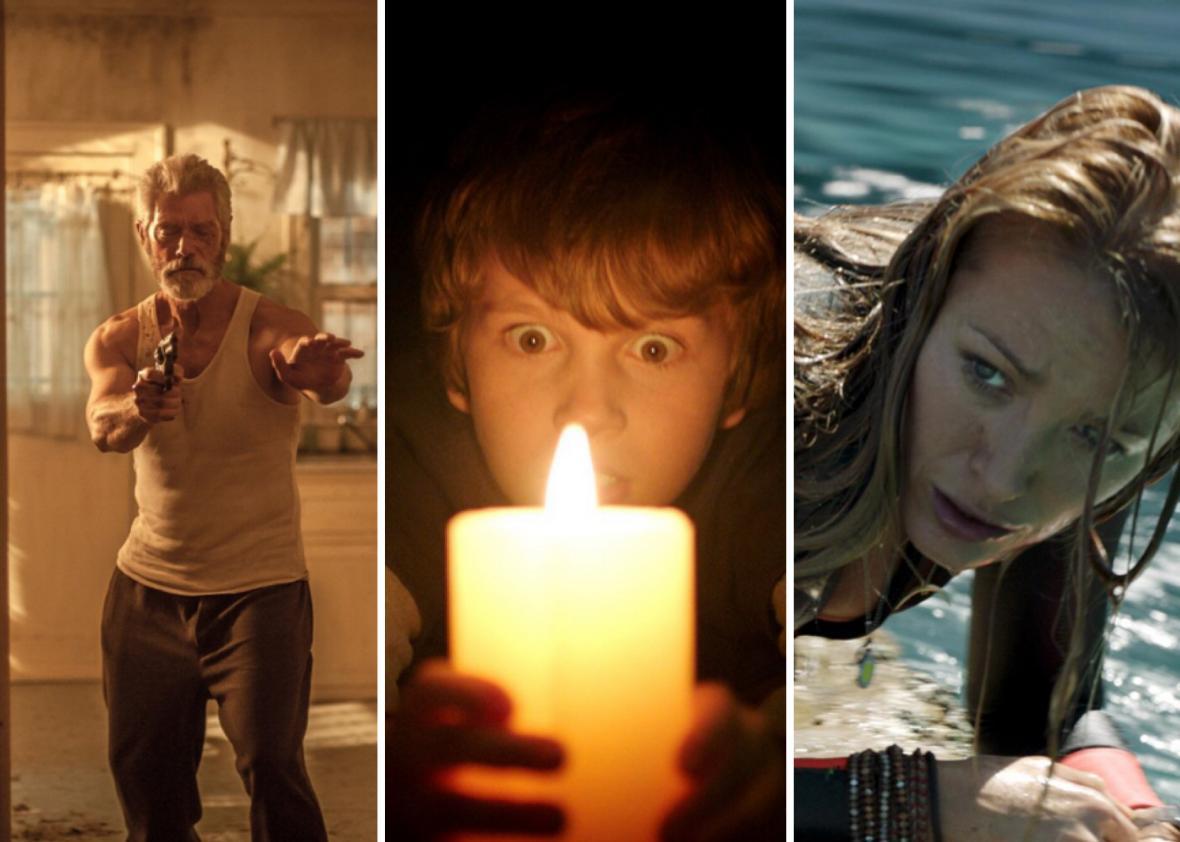The summer of 2016 has been stingy with the joys that great mainstream movies provide. There’s been plenty to watch at the art house or stream at home, but the massive entertainments that light up your pleasure centers—the ones we just call “summer movies”—have fallen wide of the mark. Remember Jason Bourne and The Legend of Tarzan? Remember (shudder) Suicide Squad?
Children’s movies like Finding Dory, The BFG, Pete’s Dragon, and Kubo and the Two Strings have been one bright spot, dazzling with creative (and expensive) images where their adult counterparts are mainly content to blow things up. But some of the summer’s best multiplex fodder has been crafted on relatively minimal budgets by horror and thriller directors who’ve exploited the effectiveness of what you don’t see.
Take Fede Alvarez’s Don’t Breathe, a late-breaking summer hit made for a hair under $10 million that racked up over $33 million domestic in its first week. Its story is minimal, almost schematic: Three young Detroit burglars break into the house of a blind veteran only to find that he’s terrifyingly good at defending himself, and their challenge becomes how to get out without getting killed. But Alvarez and his co-writer Rodo Sayagues use that fiendishly simple premise as the occasion for a master class in sustained tension, relying almost exclusively on old-school cinematic technique.
Alvarez, who previously directed 2013’s nastily efficient Evil Dead remake, told Filmmaker magazine that he and his crew blocked out their characters’ path through the blind man’s house on a tabletop using action figures. “We’d act out the action,” he explained, “and when the blind man would chase the kids … well, if there’s a door they can run through to escape, then we would erase that door.” It’s a technique that’s been around since the silent era, and though Don’t Breathe brings some newfangled upgrades, including a fluid shot where the camera swoops down to show a revolver taped under the blind man’s bed frame, much of the movie’s exquisite tension is built through blocking and camera placement, constraining us to the characters’ points of view or letting us see, with agonizing clarity, the dangers lurking just around the corner.
Although it’s the burglars’ intended victim—played by Avatar’s Stephen Lang and identified only as the blind man—who lacks the power of sight, Don’t Breathe effectively gives him the advantage, leaving his adversaries stumbling around in the dark while he hunts them down. At one point, Alvarez lets the screen go black altogether, then slowly brings up the lights in monochrome night vision, so the characters’ ghostly outlines are afloat in a sea of ink. As they fumble unknowingly towards the man they’re trying to escape, all we can do is follow the title’s advice, holding our breath and praying they’ll survive.
Lights Out, which was released toward the end of July, used a similar device to equally effective ends. In David Sandberg’s horror movie, darkness is literally the enemy, the medium through which a malevolent ghost haunts the adult daughter of a woman with mental illness. When the lights are on, she’s safe, but when they go out, she can see its menacing figure slinking closer. It’s an ingenious gimmick, enough to build a short film around, which is exactly what Sandberg did before turning it into a feature, and a potent metaphor for the fear of hereditary insanity—although the movie is catastrophically irresponsible when it comes to how that analogy plays out in the end. Even so, it was enough to rack up more than $135 million worldwide at a cost of less than $5 million—a huge hit by any standards.*
But the summer’s most satisfying display of pure technique was Jaume Collet-Serra’s The Shallows, which you may remember as the one where Blake Lively fights a shark. Like Don’t Breathe, it’s cleverly constrained, set almost entirely in a few hundred square yards of ocean; a good chunk of the movie takes place on a single rock, where Lively nurses a leg wound as the tide slowly rises. The script makes a half-hearted effort to frame her struggle for survival in character terms—something about Lively processing the trauma of her mother’s death—but Collet-Serra’s far more interested in mechanics than metaphor.
The mechanics of The Shallows, fortunately, are glorious. Watching the movie is like riding in a finely tuned sports car after chugging around town in a beat-up jalopy. With $17 million to spend—still a pittance by Hollywood standards—Collet-Serra can give Lively more than a cardboard fin in the water to push against, but he still keeps his sharp-toothed antagonist at a distance, or hidden beneath the waves, for much of the film.
In Jaws, Steven Spielberg was famously forced to minimize his shark’s on-screen presence because the expensive mechanical model he’d built rarely functioned as promised, but that constraint proved to be an enormous blessing in disguise, and Jaws’ unprecedented success was pivotal in transforming summer from a relatively dead season for moviegoing into the tentpole-dominated theme park it’s become. At the same time, it set a template for filmmakers calculating when and how much to reveal. It’s often said that the scariest things are the ones you don’t see, and although that rule has its exceptions—think the maximalist horror movies of Guillermo del Toro, whose monsters are even more terrifying in bright light—it’s a credo that some of the year’s most effective movies have done well to heed.
*Correction, Sept.6, 2016: This article originally suggested that Lights Out made more than $125 million in the U.S. It made more than $135 million worldwide, but its domestic gross stands at $65 million.
Read more in Slate:
When Should You Show the Monster? The Rules of “Cinematic Foreplay.”
